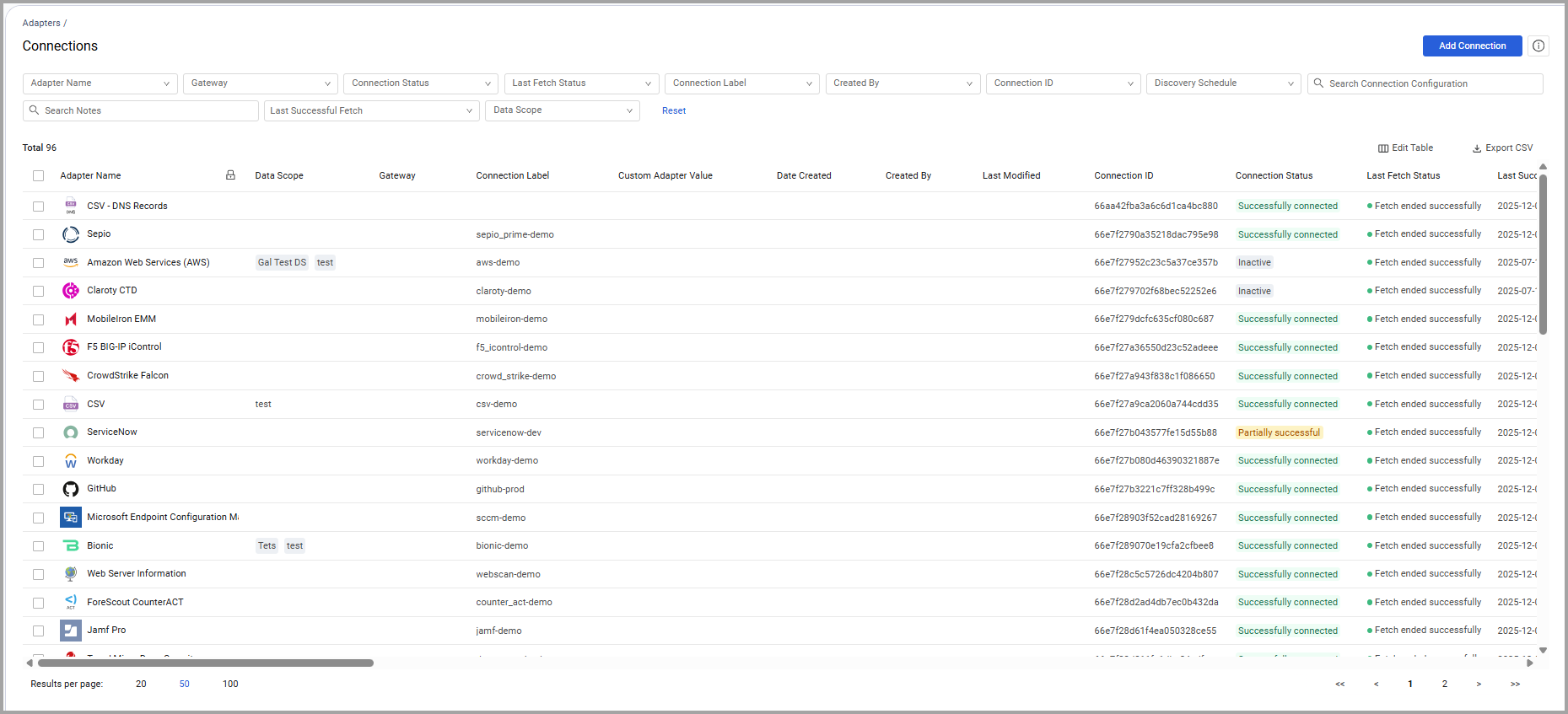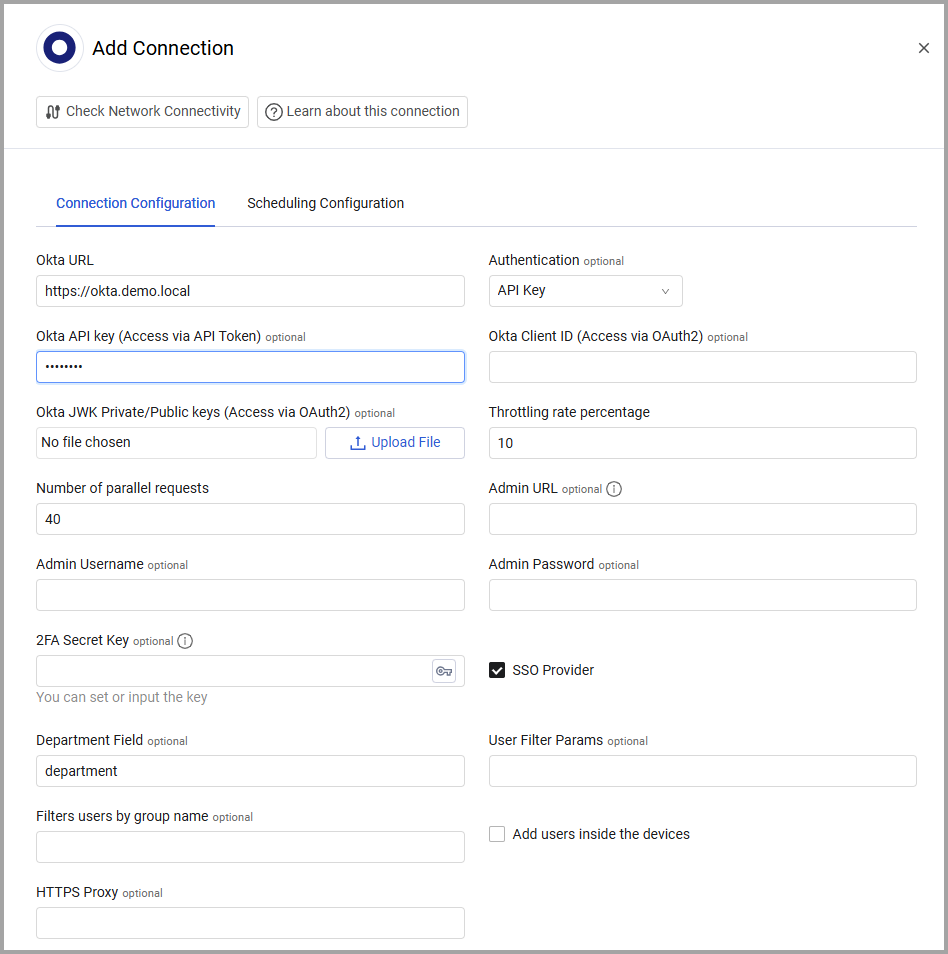Adapter Connections
From the Adapters page, click Adapter Connections to open the Connections page. Right click Adapter Connections to open it in a new tab. You can also open this page from any single adapter. Use the adapter Connections page to see a centralized summary of information about all adapters and their connections. You can see the discovery schedule of each adapter and any adapter connections that have custom discovery schedules as well as some of the advanced settings configured. In addition, you can see the polling schedule for each adapter. From the Connections page you can add connections, and you can also perform actions on a single connection or in bulk on a number of selected connections.

The following information is displayed:
- Adapter Name - The name of the adapter.
- Gateway - The name of the gateway through which the connection is made.
- Data Scope - If the adapter connection is restricted by a data scope, the name of the data scope.
- Connection Label - The connection label (if configured).
- Custom Adapter Value - A custom value added to the adapter (if configured).
- Date Created - The time and date the connection was created.
- Created by - The user who created the connection.
- Last Modified - The time and date the connection was last modified.
- Connection ID - The connection ID.
- Compute Node - The specific compute node the adapter and connection were initiated from.
- Connection Status – The status of the connection: 'Active and connected', 'Active with errors', 'Inactive' or 'Partially connected'
- 'Partially connected' means that the adapter is partially connected, it has begun to fetch data, but is not fetching all the assets that it can. Click on the adapter connection to see an explanation (available for specific adapters).
- Last Fetch Status - Displays the status of the last fetch as displayed on the Adapter Fetch History page:
- Connection failed
- Fetch ended successfully
- Fetch ended with errors
- Fetch failed
- Fetch skipped
- Fetch started
- Fetch terminated
- Last Successful Fetch - Shows the time and date of the last fetch that was successful for this connection.
- Discovery Schedule (UTC) – This shows the discovery schedule. While some adapters are set to the default discovery, others may have custom discovery settings that were set using the Advanced Configuration tab for the connection. If adapters are set for real time discovery, this is also displayed.
- Advanced Configuration - Shows if advanced discovery for each adapter connection is set separately, or the same configuration is used for all connections. Settings may be, 'Adapter Level', 'None' or 'Connection Level'.
- Connection Configuration - Displays the configuration of each adapter connection in JSON format.
Note
Sensitive data, such as passwords and private keys, aren’t displayed in the JSON.
- Adapter Configuration Advanced Settings
The following fields display values set in the Adapter Configuration Advanced Settings for the adapter. Refer to Adapter Advanced Settings for detailed information about each setting.
- Ignore Not Seen Devices (hours) – Displays the number of hours set in the 'Ignore devices that have not been seen by the source in the last X hours' field in the Advanced Settings for this adapter or connection (if custom settings set).
- Ignore Not Seen Users (hours) – Displays the number of hours set in the 'Ignore users that have not been seen by the source in the last X hours' field in the Advanced Settings for this adapter or connection (if custom settings set).
- Hold before Fetching (hours) – Displays the number of hours set in the 'Override the global discovery schedule for this adapter to wait X hours before fetching' field in the Advanced Settings for this adapter.
- Wait for Response (seconds) – Displays the number of hours set in the 'Wait for a response from the source for up to X seconds' in the Advanced Settings for this adapter.
- Ignore Matching Assets – Displays whether the 'Ignore matching assets from the source if a subsequent asset was seen by the source before the previously fetched asset' in the Advanced Settings for this adapter is set or not.
- Delete not Seen Devices (hours) – Displays the number of hours set in the 'Delete devices that have not been returned from the source in the last X hours' in the Advanced Settings for this adapter or connection (if custom settings set).
- Delete not Seen Users (hours) – Displays the number of hours set in the 'Delete users that have not been returned from the source in the last X hours' in the Advanced Settings for this adapter or connection (if custom settings set).
- Wait for Connection (seconds) – Displays timeout for how long to wait for the connection to the source in seconds.
- Failed Connection Attempts before Inactive – Displays the number of failed attempts to connect before setting the adapter or connection (if custom settings set) to inactive. This number includes all connections to the server, including periodic connection updates (if set in Data Aggregation Settings).
- Failed Connection Attempts before Fetch Failure - Displays the number of failed attempts to connect before fetch failure.
- Terminate after X hours of an active fetch - Displays the number of hours set in the 'Terminate after X hours of an active fetch' field in the Advanced Settings for this adapter.
- Notes - Any notes added on the Adapter Connection Configuration page.
Setting Page Columns Display
Use Edit Columns to set the columns displayed on the page and save them as a Saved View and thus see fields most relevant to you. Drag and drop columns on the table to arrange them in the order you want.
Filtering the Display
You can filter the display by the following fields:

-
Adapter name - The name of the adapter. Once you filter by adapter name, the Connection label, Connection ID and Compute node displayed are those relevant for that adapter.
-
Gateway - The name of the gateway through which the connection is made.
-
Compute Node - The name of the compute node.
-
Connection Status – The status of the connection: 'Active and connected', 'Active with error', 'Partially Connected' or 'Inactive'.
-
Last Fetch Status - The status of the last fetch as displayed on the Adapter Fetch History page.
-
Connection Label - The connection label (if configured).
-
Connection ID - The connection ID.
-
Discovery Schedule – The discovery schedule, this is ‘Global', 'Custom’ or 'Real time'.
-
Search Connection Configuration - Search adapter connections by a key, value or combination of a key and string value of an adapter connection configuration. Note that all values are searched as string values. To search multiple values, they must be adjacent, and with the exact syntax that appears in the Connection Configuration column.
-
Search Notes - Search Notes.
-
Last Successful Fetch - Set a time range for the last successful fetch, to display only fetches in that time zone.
-
Data Scope - If the adapter connection is restricted by a data scope, the name of the data scope.
-
You can use Select all, and Clear all in any of the filters to select or clear all of the options.
-
Click Reset to clear all filters.
Sorting the Display
Click on a column to sort by a specific value.
For instance, you can sort by Connection Status.

Editing Connection Information for a Specific Adapter Connection
You can edit connection information for a specific adapter connection.
- Click on a connection.
- Click anywhere in the row (except on the adapter name).
- The Connection drawer opens with the configuration information for this connection

- Edit this information as required.
Adding a New Connection
You can add a new adapter connection either from the Adapters page or from the Connections page. Learn more about Adding a New Adapter Connection.
Connection Actions
You can perform actions on a single connection or in bulk on a number of selected connections.
Fetching Adapter Connections
- You can run fetch on one or more adapter connections.
- Hover over one adapter, or select one or more adapters.

- Select Fetch.
Activating Adapter Connections
- You can activate one or more adapter connections.
- Hover over one connection, or select one or more connections. You can only select connections that were already configured previously.

- Select Activate. The selected connections are activated according to their configuration in the adapter connection drawer. If for any reason it is not possible to activate all the connections, the system shows an appropriate message.
Deleting Connections
- You can delete one or more adapter connections.
- Hover over one adapter, or select one or more adapters.

- Select Delete.
- A dialog box opens asking you to confirm. You can select to 'Also delete all asset entities that were fetched by this connection'. When you select this option, the assets on this connection begin to be deleted immediately. If a fetch is in progress it is not terminated, so you might have to run delete again to make sure everything is deleted.
Exporting Adapter Connections to CSV
You can export the Adapter Connections table data to a CSV file. To export the results to a CSV file:
In the Adapter Connections page, click Export CSV on the right side of the page just above the table.
The CSV file is automatically downloaded with a name format of:
adapters_connections_< date >T< time >UTC.csv
Depending on your operating system settings, you may be able to edit the file name.
For general information about working with tables, refer to Working with Tables.
Updated 3 days ago
